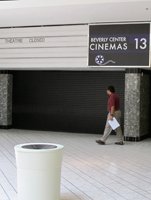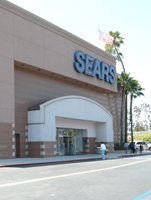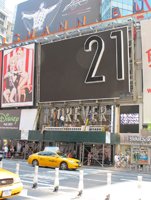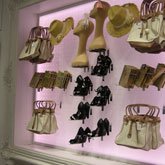Forever 21 Takes an Imaginative Approach to South Coast Plaza
Forever 21 seems to be everywhere. But the one spot that has eluded the Los Angeles fast-fashion retail chain is South Coast Plaza, located in affluent Costa Mesa, Calif.
But that may change.
In an unusual move, the rapidly expanding company is looking into taking a 40,000-square-foot slice out of the huge Sears store that anchors one wing of the mammoth mall, which is home to many luxury stores—such as Saks Fifth Avenue, Bloomingdale’s, Max Mara, Gucci and Tiffany & Co.—as well as other fast-fashion retailers, such as H&M and Zara.
“We are working on it,” Larry Meyer, executive vice president at Forever 21, said of plans to take some of Sears’ space. “But nothing has been finalized.”
Sears Holdings Corp., based in Hoffman Estates, Ill., filed plans in March with the Costa Mesa Planning Department to reconfigure some of its main building’s 274,317 square feet of space and create a new mall entrance and retail store.
Sears declined to comment on its plans, but Forever 21 did admit it was eyeing taking over the space from the traditional department store, which stocks everything from washing machines, refrigerators and camping equipment to swimwear, dresses and suits.
“Before, we couldn’t find the right location [at South Coast Plaza],” Meyer said. “It is a great center.”
Indeed, South Coast Plaza is one of the premiere retail centers in the region. According to its website, 23 million shoppers visit the sprawling center every year. There is everything from fancy furniture stores, jewelry stores, shoe shops and kitchenware boutiques to well-stocked department stores, a variety of clothing emporiums and a slew of restaurants.
“This is a great mall for Forever 21 to be in, even if it is high-end,” said Jeff Green, a retail consultant in Phoenix. “That is one of the great things about Forever 21. They can go into a moderate mall like Cerritos [the Los Cerritos Center in Cerritos, Calif.] or a high-end mall and do extremely well.”
Shrinking the Sears store is one way of improving the dowdy department store’s bottom line. Sears’ domestic stores haven’t been doing well in recent years. Until the first quarter of this year, same-store sales at the massive chain hadn’t grown since 2004.
That changed during the first three months of this year, when same-store sales for Sears domestic grew 1.2 percent, due mainly to the company partnering with state agencies to sell energy-efficient appliances.
At South Coast Plaza, Sears is in a unique position. It owns 845,064 square feet of space at the shopping center, or a little more than one-third of the center’s 2.8 million square feet, said South Coast Plaza spokesperson Beverly Morgan. It was a perk for being one of the first tenants when the shopping center, built on former lima bean fields, opened in 1967.Boom box
Leasing square footage from Sears might be cheaper for Forever 21 than trying to rent space in another part of the mall. In the last few years, the fast-fashion purveyor of merchandise that rarely sells for more than $50 has been on a bargain hunt for inexpensive store locations. It has taken over several big-box outlets once occupied by now-defunct Mervyns and Gottschalks.
In a few weeks, Forever 21 is opening a New York flagship store in Times Square, moving into a 91,000-square-foot spot once home to a Virgin Megastore.It is also expanding at Los Angeles’ Beverly Center, where it will build in an area being vacated by the movie theaters at the mall.
“We are opening or relocating quite a few locations,” Meyer said, noting the company, with close to $2 billion in revenues in 2009, expects to have 500 stores in its lineup by the end of the year, up from roughly 450 last year.
One of its largest stores is the one in the Los Cerritos Center. The 88,000-square-foot former Mervyns looks like a Forever 21 store on steroids. It opened in January and carries every Forever 21 division, from childrenswear, lingerie and makeup to menswear, womenswear and plus sizes. It also carries some of the company’s higher-end labels, such as Love21 and Twelve by Twelve. Chaos has been replaced by neatly organized sections that house different categories. Elegant chandeliers dot the ceilings. The floors are paved with marble tiles. There is space to move around.
The store has 196 mannequins, 86 fitting rooms, 24 cash registers and 263 employees, whose average age is 21, said store manager Summer Pelger. Only 30 of those employees are full-time.
“We are heavy in foot traffic on Friday nights,” Pelger said, noting that many of the store’s customers, mostly teen-agers and 20-somethings, are prowling for a hot item to wear that night.
In many ways, this is the Forever 21 of the future. The company took over 12 Gottschalks department stores last year, buying three and leasing nine from the bankrupt Fresno, Calif.–based chain, Meyer said. It also took over 15 Mervyns store last year. The average size of a Mervyns store is 80,000 square feet. In the past, Forever 21 stores have ranged in size from 7,000 square feet to 20,000 square feet.Beyond borders
Forever 21’s founders, Don and Jin Sook Chang, who launched their first store in 1984 in the Los Angeles suburb of Highland Park, dreamed of converting their smaller, mall-based stores into all-encompassing emporiums. Mervyns and Gottschalks are paving the way for that.
The company is also rapidly expanding overseas. In the last few months, it has opened three new stores in Tokyo, for a total of four in that Asian city. By the end of the year, it will have outposts in Birmingham, England—its first store in Great Britain—and in Dublin. Next year, a London store is expected to open. That is on top of stores in countries such as South Korea, Malaysia, Thailand, Singapore and Bahrain.
To many, Forever 21 seems to defy the odds of expanding in a soft economy. While many chains are thinking about reducing their store numbers, the Los Angeles retailer is expanding rapidly. Meyer predicted that revenues in 2010 would come close to $3 billion, a 33 percent jump over last year.
With such rapid expansion, there are doubters who think the company is taking on too much space too fast. “I think what we have all learned in the recent downturn is that bigger isn’t necessarily better,” Green, the retail consultant, said. “When Chico’s decided to expand their stores five years ago to a larger format, they saw very little sales increase. Gap had the same problem. You just don’t get the sales performance to warrant the larger size.”


























